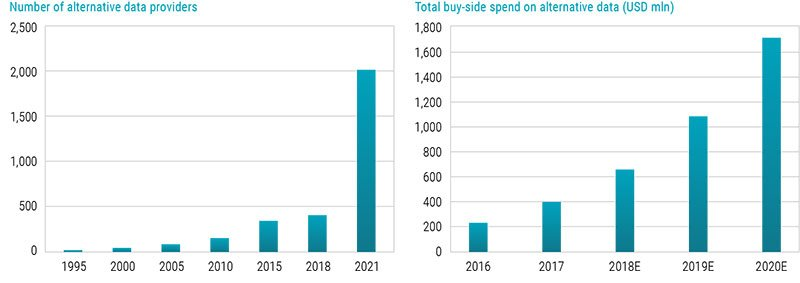The concept of getting the best data is not new. During the Napoleonic wars, a group of European bankers set up a Europe-wide network of messengers and carrier pigeon stations to gather battleground information as quickly as possible.
Since then, investors have found other ways to obtain information to gain an advantage. Traditional financial data typically consists of financial statements and other company disclosures, combined with brokerage information. Most come from a few centralized sources, led by the company itself, sell-side analysts, and stock exchanges.
But since the mass adoption of the internet and smartphones in the 21st century, alternative data is now more popular. This can come from various sources, such as satellite images, credit card spending, and even web blog comments. Research shows that there are about 180 data marketplaces, 2,000 data providers, and more than 200,000 datasets.1 Average spending to acquire this data has also risen, as shown in the charts below:

Source: Robeco, AlternativeData.org, and Azcoitia, Iordanou, and Laoutaris (2021)
The four Vs
Compared to traditional financial data, alternative data sources are characterized by the four Vs:
Volume: The amount of information from alternative financial data sources dwarfs that from standard financial data
Velocity: Alternative financial data creation and dissemination is much faster
Variety: An endless variety of sources, such as figures, text, images, or even audio/video files that are much richer
Veracity: It can be crowdsourced and disseminated without rigorous controls and may be false or misleading.
So, the alternative data marketplace is a rich ecosystem with pros and cons. Therefore, investors who use alternative data need the skills to extract valuable insights and avoid misleading information.
Applying the data
Alternative data also allows users to gain a different insight or perspective than investors who only use traditional data. A good example can be seen in the blogs that Chinese retail investors use to gain insights into the A-shares market.2 Investors who read these blogs have an informational advantage in short-term investor flows compared to those who wait for the publication of the following quarterly report.
And alternative data can be essential when it comes to sustainable investing. Traditional data on issues such as carbon emissions or gender diversity comes from corporations and tends to be backward-looking. Understanding how a company plans to align itself with the energy transition requires a more forward-looking approach. And looking at executives’ biographical data and employees’ profiles on networking sites allows analysts to get a better sense of a company’s actual levels of diversity.
Alternative data in investment processes
So, how do institutional investors use alternative data in their investment processes? This can, broadly speaking, be split into quantitative or fundamental approaches. Quant investors were the early adopters and had been using alternative data on a large scale. Their investment process involves establishing an investment hypothesis, which is tested through statistical and mathematical analysis of financial data – the classical scientific approach.
The wide availability of alternative data broadens the types of investment hypotheses that quant investors can investigate. For example, suppose we want to examine if better employee morale leads to a company’s long-term outperformance. This question is impossible to answer if you only use financial statements or stock price data. However, using information from websites like Glassdoor means researchers can examine whether companies with high employee sentiment will outperform those with lower morale.3
Conversely, fundamental investors have mostly not adopted alternative data since investment decisions are based on the judgment of individual managers. Instead, they examine financial statements, speak to company management and observe the popularity of various products and services. Thus, much of the intangible information encapsulated by alternative data is observed directly via human activities.
Frequently asked questions
There remain frequently asked questions, the most common of which is where can investors source alternative data? The most straightforward approach is to use alternative data aggregators and brokers, such as Neudata or Eagle Alpha. Another popular channel is service providers such as Bloomberg and FactSet, who now also provide alternative data alongside traditional financial data.
Another popular question is how much does it cost? Not as much as one might imagine. In the early 2010s, alternative data vendors often asked for upwards of a million dollars, even for datasets with a low breadth and non-granular information. Now that it has become more mainstream, the cost has come down to below USD 100,000, and the median dataset price is currently around USD 17,000 per year.4
So, what is required to process it? Many investors realize that the bottleneck is not finding alternative data, but rather having the technical skills and infrastructure needed to onboard and process it all. Whereas traditional financial data can be stored in spreadsheets and processed with simple statistical tools, alternative data requires more sophisticated tools such as machine learning.
Finally, which dataset should be chosen? Although investors can often trial alternative data for free, the time required to properly investigate if it actually adds value is still significant. From our experience, experienced alternative data users typically only onboard five to ten new datasets per year. Part of the reason for this low quantity of data onboard is the time requirement.
You still need fund management
Ultimately, the investors create real value in the investment process by transforming the data of whatever kind into actionable portfolio decisions, irrespective of whether they are part of a quantitative or fundamental investment style.
Based on alternative data, we can, though, ask more exciting research questions and create more value through enhanced performance and investment solutions that are better aligned with client goals.
This article is an excerpt of a special topic in our five-year outlook.
Read the full Expected Returns 2023-2027 here
免責聲明
本文由荷宝海外投资基金管理(上海)有限公司(“荷宝上海”)编制, 本文内容仅供参考, 并不构成荷宝上海对任何人的购买或出售任何产品的建议、专业意见、要约、招揽或邀请。本文不应被视为对购买或出售任何投资产品的推荐或采用任何投资策略的建议。本文中的任何内容不得被视为有关法律、税务或投资方面的咨询, 也不表示任何投资或策略适合您的个人情况, 或以其他方式构成对您个人的推荐。 本文中所包含的信息和/或分析系根据荷宝上海所认为的可信渠道而获得的信息准备而成。荷宝上海不就其准确性、正确性、实用性或完整性作出任何陈述, 也不对因使用本文中的信息和/或分析而造成的损失承担任何责任。荷宝上海或其他任何关联机构及其董事、高级管理人员、员工均不对任何人因其依据本文所含信息而造成的任何直接或间接的损失或损害或任何其他后果承担责任或义务。 本文包含一些有关于未来业务、目标、管理纪律或其他方面的前瞻性陈述与预测, 这些陈述含有假设、风险和不确定性, 且是建立在截止到本文编写之日已有的信息之上。基于此, 我们不能保证这些前瞻性情况都会发生, 实际情况可能会与本文中的陈述具有一定的差别。我们不能保证本文中的统计信息在任何特定条件下都是准确、适当和完整的, 亦不能保证这些统计信息以及据以得出这些信息的假设能够反映荷宝上海可能遇到的市场条件或未来表现。本文中的信息是基于当前的市场情况, 这很有可能因随后的市场事件或其他原因而发生变化, 本文内容可能因此未反映最新情况,荷宝上海不负责更新本文, 或对本文中不准确或遗漏之信息进行纠正。


